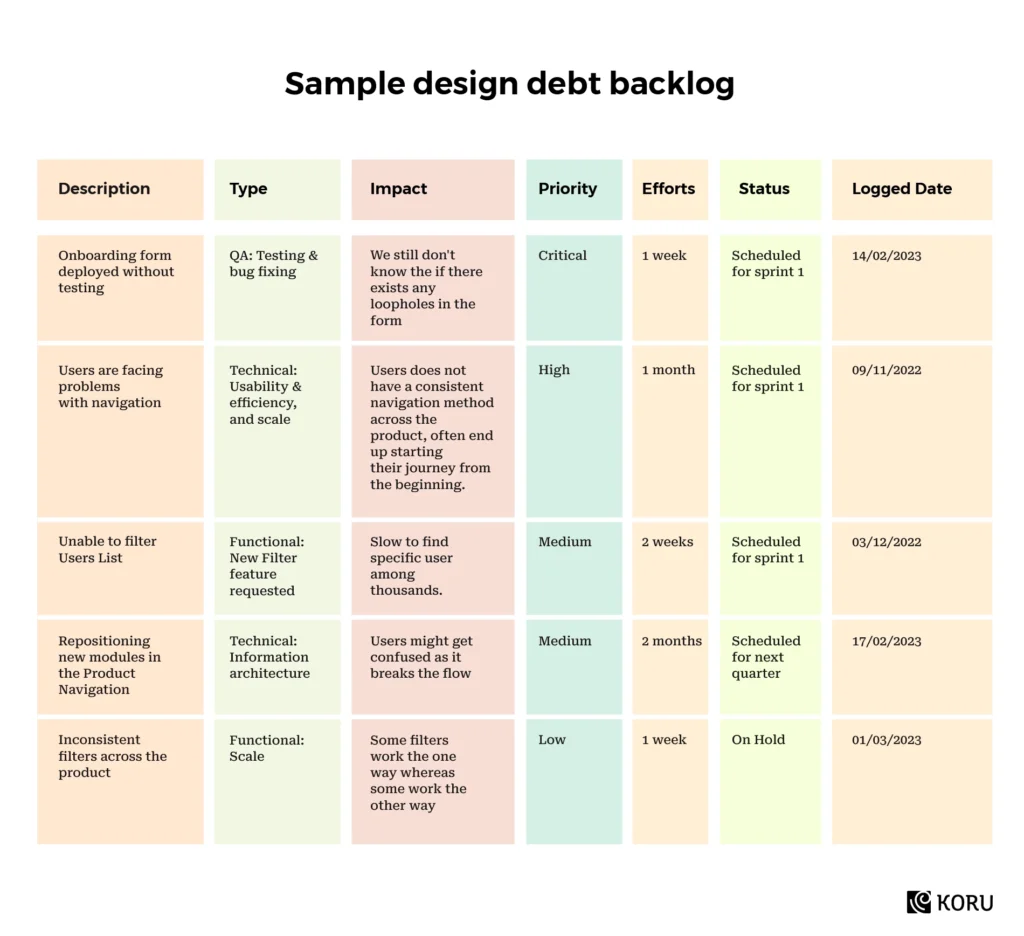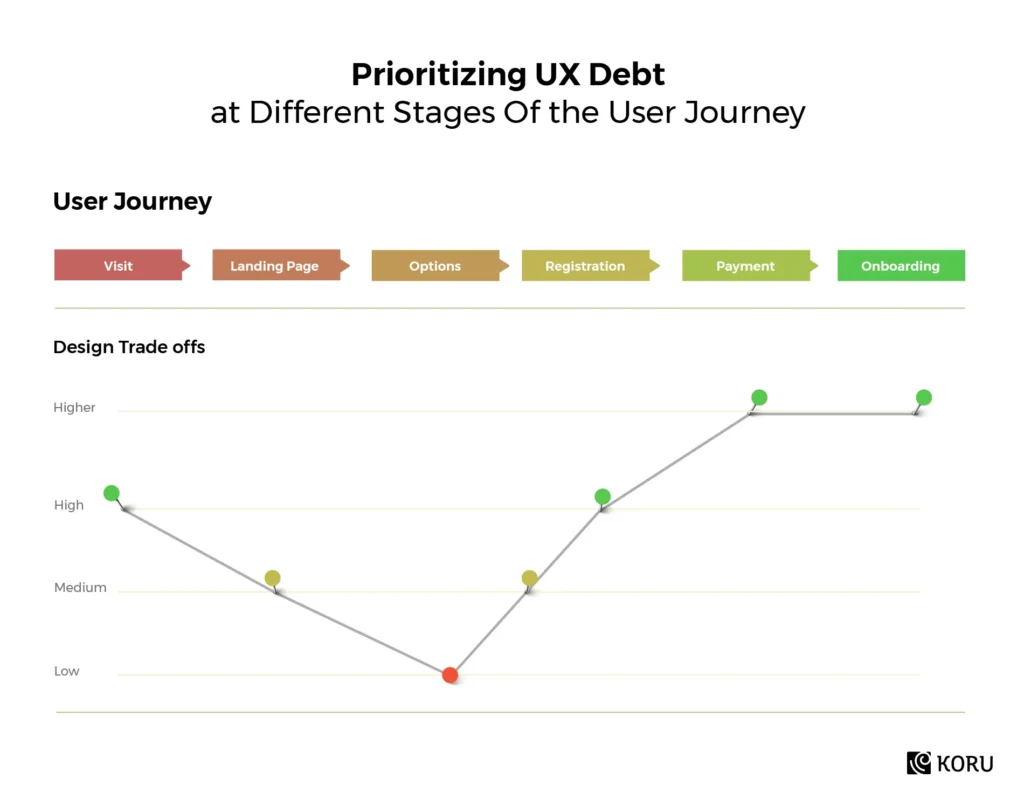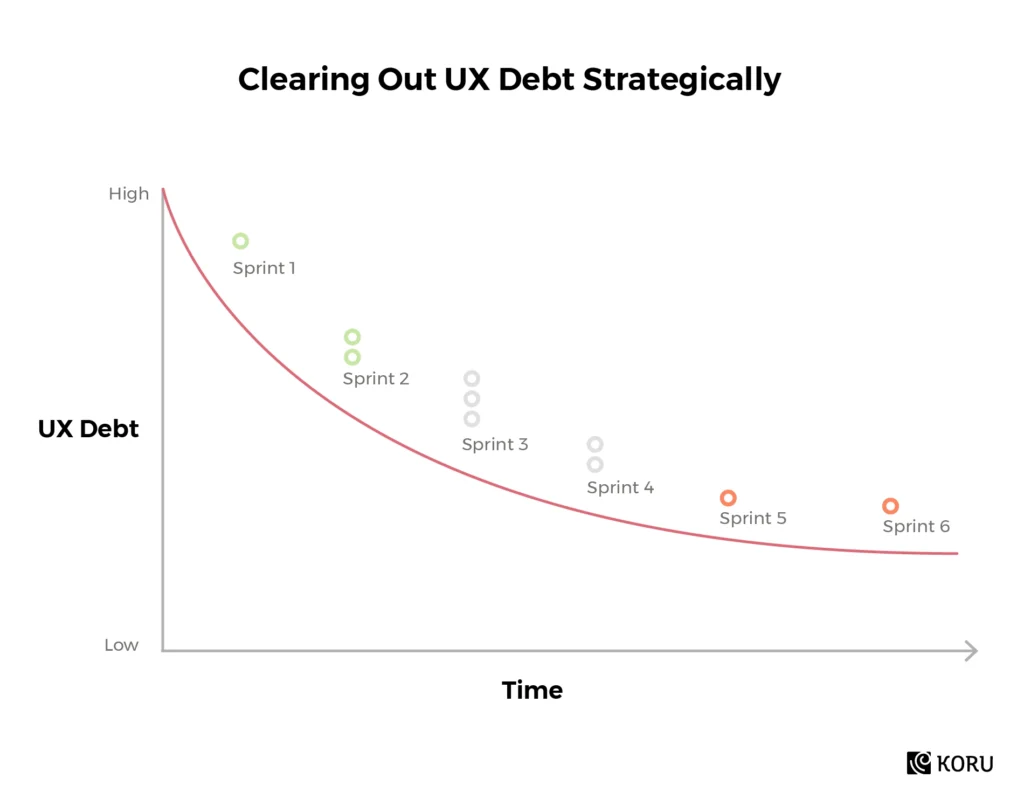Picture this: You have been hearing a lot about the dysfunctionality of your system’s filters. You know they are not working for your users. But fixing them across the products will be costly and time-consuming. Meanwhile, you’re working on a new feature that is strategically more important to your business.
So you make an exception — for the first time ever in your product’s lifecycle, thinking:
“Let’s just introduce a new filter that works better rather than fixing the existing one.”
There!
You just introduced design debt to your product.
Now your new filters work differently from the filters in the rest of your product. And it makes your user experience as inconsistent as ever.
This is just one example of collecting design debt. Every time you introduce a new feature without usability testing, push a redesign to the back burner or pick an easy alternative that doesn’t align with the original plan that you had envisioned, you’re adding to your design debt. So…
What is UX design debt?

In her talk with Mind The Product, Bansi Mehta says,
Design debt is the residual work you collect by taking shortcuts during or after the design phase.
UX debt is similar to technical debt, which is the extra time and effort required to launch easier or faster technical solutions instead of the best approach. It ends up costing more as it requires going back to fix problems after the launch, compared to launching the optimal solutions in the first place. In other words, UX debt is repaid with astronomical interest.
What causes design debt?
Design debt can be a result of the notorious “fast-fail” environment, which is a cultural phenomenon.
There exist teams that are fixated on cramming user testing, analysis, redesign, and design-developer hand-off into a single two-week sprint. These tight timelines and project constraints usually result in a massive amount of design (and technical) debt.
When you’re under such severe time constraints, one of the first things to disappear is documentation. This means you’re often relying on your developers to interpret your design without any hiccups. And that’s not the only problem. User testing, brand consistency, and product vision can also fall by the wayside when you prioritize fast and “iterative” solutions.
Other factors that contribute to UX debt include:
- Skipping user testing
- Disregarding brand standards and style guides
- Design by committee
- Misinterpreting the product vision
- Acquiring or merging with other products
- Poor communication or collaboration
- Insufficient QA testing
- Dealing with legacy code
- Delayed refactoring
The good news is, you can start paying off your design debt by attacking one of its core problems – the lack of clarity on what needs to be done. Here’s how.
6 Tips To Keep Your Products Free of UX Design Debt
“You might think that rewrite will only take a few months, but invariably it takes far longer, and you are forced to sit by and watch your customers leave you for your competitors.”
Marty Cagan, Partner, Silicon Valley Product Group
UX debt has a compounding effect – the longer it remains unpaid, the more it costs to pay it off. Therefore, it makes sense to consistently keep track of it and reign it in. Here are six ways to help you start cleaning up this design debt mess before it comes back to bite you!
Maintain a UX design debt backlog
tl;dr: Document the debt and make sure you capture it in the backlog.
It’s important to keep track of design debt, just like technical debt. This means documenting any UX debt (intentional or identified) and adding it to the backlog.
To start off, get to the root cause of what triggered the design debt.
Was it a rushed launch, was it conflicting inputs, or was it an alternative approach due to time constraints?
Ignoring the source of the debt will only make things worse.
One possible way to do this is by utilizing a spreadsheet that is shared across the teams while assessing the product as a group. Here’s an example of the same:

As suggested by Susan Rector and Kim Dunwoody, you can review your products based on the following criteria:
- Findability
- Accessibility
- Clarity of Communication
- Usefulness
- Credibility
- Learnability
- Overall Aesthetics
- Persuasive Design
UX audit can be a great way to identify inconsistencies and loopholes across your system. It involves examining the existing user journeys to reveal actionable areas of improvement.
Prioritize UX Debt for Critical User Journeys
Don’t sweat the small stuff.
Resolving UX debt across the end-to-end user journey is ideal, but it’s always possible that you may discover more problems than you can realistically address. And, hence a strategic approach is necessary.

For example, a design issue that affects a component on your invoice generation page may not have a significant impact, but if the same issue occurs on your checkout or user onboarding journey, it could greatly affect your users and business.
So you must prioritize based on the significance of these journeys.
Incorporate Consistent Design Practices Across The Team
There’s a term called “designer-specific debt” that every organization dreads.
It’s when your design systems are in disarray. Neglecting to maintain your design libraries — be it due to the lack of time or discipline — can lead to catastrophic outcomes.
This is especially bad when you’re working on a large-scale product or a suite of products. In that case, design language inconsistency affects the entire ecosystem of products. It ultimately slows down your team’s ability to create new designs.
The only way out is to actually take out time to update and maintain them. Have your team document the changes in your design language so that everyone can be on the same page. You can also conduct monthly, or even quarterly internal peer reviews to ensure that nothing gets missed.
Here’s how we approach this problem:
As an organization, our designers found that it’s more effective to regularly review our design systems for all of the products instead of waiting until things get out of control. So, every week or two, the designers look at the existing design systems for each product and then an individual outside of the team will review the entire system, validate it, and identify any discrepancies that need to be addressed.
Although this isn’t necessarily part of all sprint planning, the design team understands that it’s an important aspect of making it easier for everyone. So whenever they’re stuck in any downtime or between feedback cycles — they utilize this time to work on design systems. Additionally, we dedicate time after every couple of sprints to focus specifically on this task.
Allocate Enough Time To Clear The UX Debt
Addressing UX debt can seem like an overwhelming task, but there are effective ways to tackle it while continuously improving your product.

One approach is to allocate a specific number of UX debt tasks to be resolved during each sprint or every alternate sprint, with the number of tasks adjusted based on the overall workload. Prioritized tasks should be regularly addressed, with 1-2 UX debt tasks frequently tackled.
Another option is to schedule quarterly sprints dedicated solely to UX debt, with the team collectively deciding which areas to focus on during the cleanup sprint. If a full sprint is not feasible, dedicate a day or two to tackle as many UX debt tasks as possible.
Tips To Get Stakeholders On Board
Make sure that stakeholders and leadership are equally invested in addressing UX debt. Here are a few tips to go about it:
- Prepare simple visualizations based on findings from user testing sessions.
- Provide clear explanations of progress made during each sprint and its impact on product functionality.
- Demonstrate progress and convey it in terms of business value generated.
Schedule Regular Design Tests And Reviews
Every team has its own unique blind spots. To avoid potential UX crashes, it’s wise to seek an independent third-party design review. This fresh perspective provides an extra layer of assessment before releasing a product, ensuring minimal UX debt in the long run.
Regular design reviews provide designers and developers with an opportunity to collaborate and better understand each other’s disciplines. In addition, periodic design reviews help to identify and address potential issues early on in the product development process.
User testing sessions are also crucial in identifying UX debt, but prioritization becomes critical to manage the different types of debt effectively. By prioritizing the most critical user journeys based on product strategy and relevant data, teams can allocate resources and address UX debt in a more strategic manner.
Take Preventive Measures From The Get-Go
This is more of an add-on point, but an important one.
In her talk with mind the product, which I mentioned earlier, Bansi also shared the complications of working in the healthcare industry which requires a lot of compliance and regulations.
“In many healthcare product teams, accessibility is often ignored at the time of inception,” she says. As the organization grows, this oversight becomes more pronounced, and product managers are forced to address it.
This may involve hiring additional personnel and dedicating significant time and resources to the task. In some cases, ongoing projects may need to be halted in order to tackle the issue effectively.
If only they would have planned it from the outset!
Defining and implementing design best practices across the entire team hence becomes essential. Make it a mindset and integrate it into the product development process from the beginning.
UX Is Ever-Evolving, And So is UX Debt
UX debt is like the mythical Hydra – cut off one head and two more shall take its place.
You can strive to keep it manageable with the tips outlined above, but there’ll always be something to take care of.
There will always be trade-offs between user experience and technical feasibility, and the ever-changing landscape of UX trends will continue to pile on the debt.
Having said that, the key to success lies in balancing the competing perspectives of designers, engineers, and users. It requires a mix of pragmatism, organization, and UX-Jedi mind tricks.
Consider getting a UX audit from a professional to uncover hidden UX debt and prioritize your efforts. With the right guidance, you can create a user experience that truly shines.










